An eight hour journey, on the world’s most dangerous roads, can be both tiring and exhilarating. But the views of the craggy peaks whooshing past the window, the spectacle of a turquoise ribbon of river cutting through the valley, hundreds of falls and streams merging into the river, and the bends taking you from one slice of paradise to the other, are a prize worth the madness of being on the world’s deadliest roads. And while the bus past these, nicely framed picture perfect frames, my mind weaved a story of a land of Buddhist Gompas doubling up as landmarks, prayer flags fluttering, mummies sitting still in monasteries, azure blue skies and stars dancing in galaxies at night, and above all the cultural mysteries it has held over time. I wanted to know how local people live their life here, holding natural and mystical mysteries for centuries. A land that wasn’t open for people till 1970s, a land tucked between the Himalayas and the Tibet, a land that has been called ‘world within a world’ by Mark Twain; I wondered how that land would be.

Spiti, the Himalayan region in north-western Himachal Pradesh, is starkly different in its landscape from the rest of the State. Barren mountains, fierce Spiti River, and large swathes of emptiness broken by tiny villages. The bus stopped at random shots, a small gompa, Buddhist prayer flags fluttering, a border roads sign-post, and a random tea-shop, acting as signs of civilization. I was on an eight hour journey from Rekong Peo to Tabo, a slice of Spiti before the main town Kaza. Fully momoed and maggied, at around five in the evening I reached Tabo, after passing through extraordinary landscapes from Kinnaur to Spiti, past the dot like villages of Nako, Changu, and Sumdo. The ride took me through the lush green mountains of Kinnaur to the rugged moonscape of Spiti with just a few villages in between.

Living the high life
Tabo looks just another dot, a piece of Shangri-la, or a little Himalayan playground for adventure lovers. Surely it’s more than a stop-over. The Tabo monastery is set in the center of the village, a wooden board outside it says that the monastery, the oldest in Spiti, was built in 995 AD. Though it calls for spending some time, knowing it and the new monastery built next to it, I checked into a quiet homestay perched alongside an apple orchard. A sip of butter tea, had me going for some conversations with my host on local life, the monastery, and probably the most interesting, the harvesting season of apples. As it is said, that a good conversation always leaves you more knowledgeable, I got to learn that Tabo apples are among the most prized ones in the country.


Dawn had set in, and I decided to take one eyeful of the town from the hills, where another art piece waited for me. Stairs on the hills took me to the cave shrines, where a millennium ago monks stayed. As of today, the caves lie in a dilapidated state, still a hike to the caves, gives enough angles to capture the beauty of the landscape. A flight of concrete stairs takes you to cave shrine with a temple, a kitchen, a hall, and some splendid murals that are said to date back to around the time Tabo Monastery was built..
Ajanta of the Himalayas
Tabo is rightly quoted the ‘Ajanta of the Himalayas’ for its painted wall murals. From the cave shrine, one can capture the oldest monastery, with its nine temples and few stupas, looking like mud-houses. The exterior of the monastery is craggy brown with no sign of what art and history, the interiors hold. From a distance, the red of the monks’ dresses look the only visible signs of the coloured world. Alongside the mud monastery, stands the brightly coloured recently built monastery.
I started my monastery tour from the main temple called Tsuglagkhang or the assembly hall. In this oldest structure in the monastery, the first sculpture that I met was of Ganesha, hinting at the spiritual osmosis Spiti is. There are paintings in the hall, dating back to 17th CE. Everything looked so old and preserved, taking you back ages. A little over a minute, and I got the feeling that the assembly hall requires more time. All four walls have 33 stucco work Bodhisattvas sculptures, sitting on intricately painted walls. On one of the wall is painted life story of Buddha whom the locals always call Sakyamuni Buddha. The walls have layers of history, holding stories for 1000 years.
There is little light coming from the shaft in the middle of the ceiling, but even in that darkness, the murals look mystifying. In the inner sanctum, the walls are covered with a 1,000 paintings of the Buddha. Even in that almost dark setting, the painting gleaming gold, leaves you floored.

After resolving some of the mystic of Tabo monastery, I headed towards the new monastery, gleaming like a beacon of hope in the cold desert. The monastery had closed by then, still the walk through the gompa and monastery was inspiring. It was 7:30 pm

Guge Kingdom
Kings of Guge kingdom had built this monastery under the direction of translator and monk Rinchen Zangpo. Ringchen Zangpo was a student of Nalanda University. He brought Kashmiri artists to work on this monastery and thus, you can see Kashmiri influence in painting styles.

To stay You can opt to stay in the homestays in the village. For a unique experience, monastery also offers stay options for INR 400 a night.
(This article is a part of the series capturing my travel to Lahual-Spiti, a cold desert perched high in the Himalayas, in the state of Himachal Pradesh, India)










[…] and deep gorges formed by the fierce Spiti River, is also a melting pot of cultures. My visit to Tabo and Dhankar, had made me intelligent of what to look for. The signs of Hinduism in Kinnaur, had […]
[…] 1) Kalpa and the Kinnaur sojourn 2) Dhankar, the beautiful monastery perched in the highs, 3) Tabo, the oldest monastery, and 4) Key monastery and Kibber […]